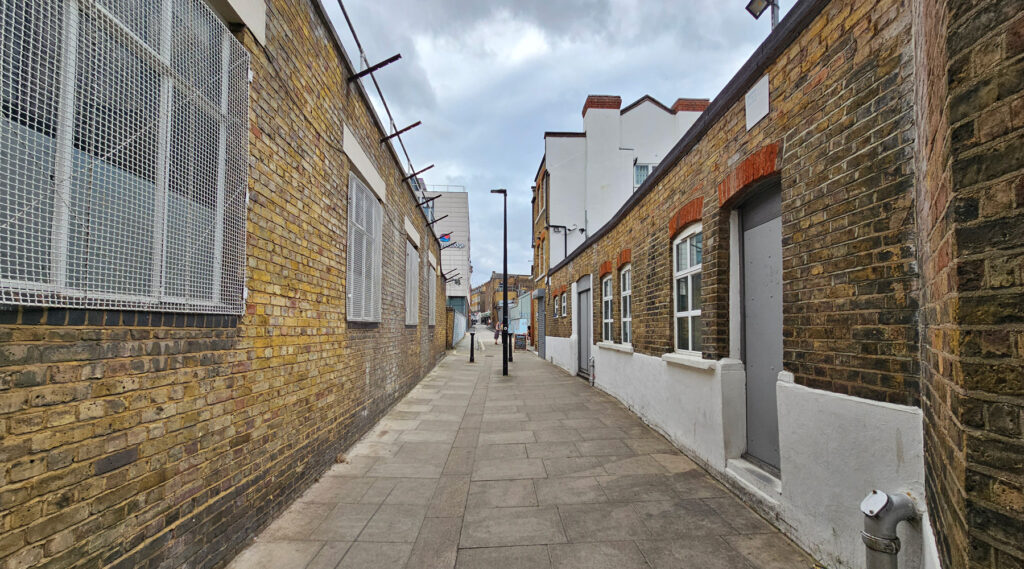This is a nice passageway in King’s Cross that leads from a covered entrance through to a cobbled (setts) alley, above a railway and ends in an ornately decorated building.
St Chad’s Place first shows up as the area is being developed in the late 1700s as a part-built road called Field Street.
It may have been renamed shortly afterwards as the area built up, as it shows up just 30 years later, possibly called something like Fifteentract Lane.
The area got a massive shake-up though when the railways arrived – specifically the Metropolitan line that runs in an often open-air cutting between King’s Cross and Farringdon. With the railway slicing a swathe through this part of London, this appears to be when the road was renamed St Chad’s Place, and also when it gained the covered entrance onto King’s Cross Road.
The name comes from something that used to be on the corner of St Chads and Gray’s Inn Road – and that was St Chad’s Well, a spring that was for a while popular for its clean waters.
It’s not St. Chad of Florida hanging, but St. Chad of Mercia, a prominent 7th-century Anglo-Saxon Catholic monk, and may have been a Welsh nobleman before turning to the cloth, and elevated to sainthood pretty much as soon as he died.
St Chad’s Well was a celebrated medicinal well and had a new pump house built in 1832. There is however no independent evidence of Chad’s visiting the site, but it clearly is named after him, and he certainly did travel in southern England. His association with wells seems ancient, and no doubt stems from the St Chad’s Well at Lichfield, visited by pilgrims and probably the water supply of his monastery.
The building and the well were both destroyed when the railway came through in the 1860s.
There are a couple of Victorian warehouse buildings here. The warehouse at 6 St Chads Place was nearly demolished in 2000, as permission was given to replace it with a block of flats. An interesting point to note is that the proposed Crossrail 2 railway may pass underneath the building, so the block of flats had to ensure their foundations wouldn’t interfere with the railway.
The block of flats didn’t get built in the end and the warehouse was saved and opened in 2004 following restoration work. Originally opened as a cafe, it became a restaurant and is now the live music venue, Jamboree.
Next to it is a three storey 19th century warehouse style building originally farriers occupied by Pusey Bros, and now called Stanley House, which is used as offices by an American university.
What you can’t ignore though is the railway that runs underneath the alley — both the London Underground and Thameslink, and you can see the closed King’s Cross Thameslink station to the north.
The station opened as one of the original seven stations on the London Underground, for the Metropolitan line, but was expanded in 1868 when the railway was widened from two to four tracks — known as the City Widened Lines.
With a long link to the mainline stations, the London Underground had plans in the 1930s to move the station closer to the mainline station, which was slowed by WWII, and then unexpectedly accelerated when WWII closed the station due to bomb damage.
The replacement platforms in front of King’s Cross station for the London Underground opened on 14th March 1941, while this station reopened for mainline services as King’s Cross Metropolitan. When the Thameslink project opened in May 1988 as a new north-south railway through London, the station was renamed King’s Cross Midland City and later, again to its final name, King’s Cross Thameslink
The station closed in December 2007 when the replacement platforms opened in St Pancras station, and you can still see the old station platforms and signage as you pass through on the Thameslink trains.
The dominant building above ground though is the grey mass of the Travelodge, however, that’s just the modern back extension of a much more interesting building that sits on the corner of St Chad’s Place and Gray’s Inn Road — which is Willing House.
Willing House was built in 1909 as offices for Willing Advertising and is exceptionally richly decorated in a Queen Anne revival style of architecture. Interestingly, the architectural style has nothing to do with Queen Anne, that’s just the name it adopted but can be identified with its use of red brick, curving bay windows, lots of ornate stone carving, and basically, pretty much any decorative style you fancy, so long as the end result was a confection for the eye.
Willing House is a good example, and if you look right up at the top, the statue is of Mercury, who typically represents communication and commerce, so quite suitable for an advertising agency.
The building was converted into the front of a hotel with a large rear extension in 1999-2002.
It’s quite possible that people going in through the grand front entrance might never know that the hotel room they are staying in is rather plainer on the outside than they expect from how the hotel looks at the front.














Love how this exploration begins unpromisingly and develops into something so fascinating. As a fan of going to places to ‘see what’s there’, I thoroughly approve of your peregrinations.